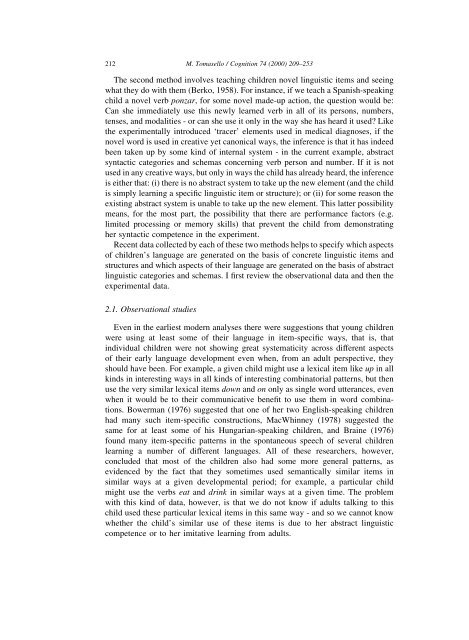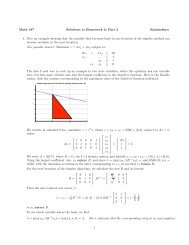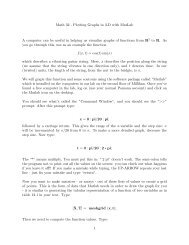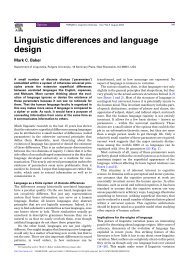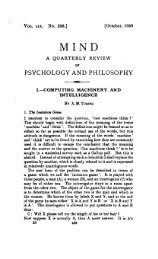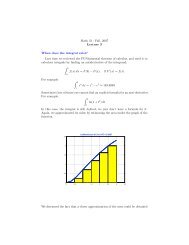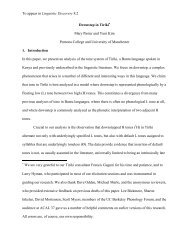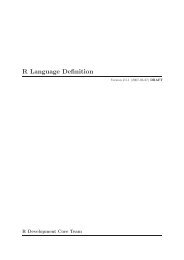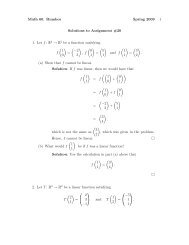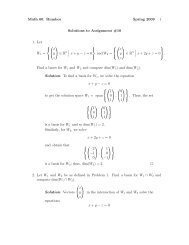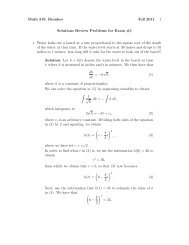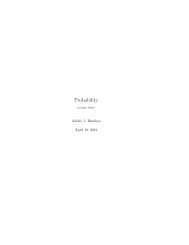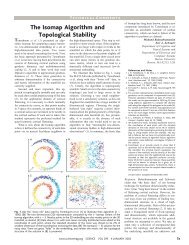Tomasello
Tomasello
Tomasello
Create successful ePaper yourself
Turn your PDF publications into a flip-book with our unique Google optimized e-Paper software.
212M. <strong>Tomasello</strong> / Cognition 74 (2000) 209±253The second method involves teaching children novel linguistic items and seeingwhat they do with them (Berko, 1958). For instance, if we teach a Spanish-speakingchild a novel verb ponzar, for some novel made-up action, the question would be:Can she immediately use this newly learned verb in all of its persons, numbers,tenses, and modalities - or can she use it only in the way she has heard it used? Likethe experimentally introduced `tracer' elements used in medical diagnoses, if thenovel word is used in creative yet canonical ways, the inference is that it has indeedbeen taken up by some kind of internal system - in the current example, abstractsyntactic categories and schemas concerning verb person and number. If it is notused in any creative ways, but only in ways the child has already heard, the inferenceis either that: (i) there is no abstract system to take up the new element (and the childis simply learning a speci®c linguistic item or structure); or (ii) for some reason theexisting abstract system is unable to take up the new element. This latter possibilitymeans, for the most part, the possibility that there are performance factors (e.g.limited processing or memory skills) that prevent the child from demonstratingher syntactic competence in the experiment.Recent data collected by each of these two methods helps to specify which aspectsof children's language are generated on the basis of concrete linguistic items andstructures and which aspects of their language are generated on the basis of abstractlinguistic categories and schemas. I ®rst review the observational data and then theexperimental data.2.1. Observational studiesEven in the earliest modern analyses there were suggestions that young childrenwere using at least some of their language in item-speci®c ways, that is, thatindividual children were not showing great systematicity across different aspectsof their early language development even when, from an adult perspective, theyshould have been. For example, a given child might use a lexical item like up in allkinds in interesting ways in all kinds of interesting combinatorial patterns, but thenuse the very similar lexical items down and on only as single word utterances, evenwhen it would be to their communicative bene®t to use them in word combinations.Bowerman (1976) suggested that one of her two English-speaking childrenhad many such item-speci®c constructions, MacWhinney (1978) suggested thesame for at least some of his Hungarian-speaking children, and Braine (1976)found many item-speci®c patterns in the spontaneous speech of several childrenlearning a number of different languages. All of these researchers, however,concluded that most of the children also had some more general patterns, asevidenced by the fact that they sometimes used semantically similar items insimilar ways at a given developmental period; for example, a particular childmight use the verbs eat and drink in similar ways at a given time. The problemwith this kind of data, however, is that we do not know if adults talking to thischild used these particular lexical items in this same way - and so we cannot knowwhether the child's similar use of these items is due to her abstract linguisticcompetence or to her imitative learning from adults.


